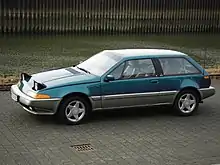| Volvo 480 | |
|---|---|
.jpg.webp) 1986 Volvo 480 ES | |
| Overview | |
| Manufacturer | Volvo Cars |
| Production | 1986–1995 |
| Assembly | Netherlands: Born (NedCar) |
| Designer | John de Vries,[1] Peter Horbury |
| Body and chassis | |
| Class | Compact car[2] (C) |
| Body style | Coupé |
| Layout | FF layout |
| Related | Volvo 440/460 |
| Powertrain | |
| Engine | 1.7 L F3N I4 1.7 L F3N turbo I4 2.0 L F3R I4 |
| Transmission | 5-speed Renault JC5 manual 4-speed ZF 4HP14Q automatic |
| Dimensions | |
| Wheelbase | 2,500 mm (98.4 in)[3] |
| Length | 4,258 mm (167.6 in) |
| Width | 1,710 mm (67.3 in) |
| Height | 1,318 mm (51.9 in) |
| Curb weight | 1,016–1,079 kg (2,240–2,379 lb) |
| Chronology | |
| Predecessor | Volvo P1800 |
| Successor | Volvo C30 |

The Volvo 480 is a sporty compact car[4] that was produced in Born, Netherlands, by Volvo from 1986 to 1995. It was the first front-wheel drive car made by Volvo and the only Volvo featuring pop-up headlights.[5] The 480 was available in only one body style on an automobile platform related to the Volvo 440/460 five-door hatchback and four-door saloon models.
It features an unusual four-seat, three-door hatchback body, somewhere between liftback and estate in form. The 480 was marketed as a coupé in Europe starting in 1986. The car was originally intended to be marketed in the United States as a 2+2 "sports wagon" in the fall 1987, although these plans were cancelled due to the continued weakness of the U.S. dollar during 1987.[6][7][8]
Development
Volvo took six years from the time the 480 was conceived, through its development, and finally brought to production readiness.[3] The press launch was on October 15, 1985, but the 480 was first put on public show in March at the 1986 Geneva Motor Show, becoming available to buyers in May 1986.[9]
Volvo described the car as a four seater with "sporty styling" and the first front wheel driven Volvo.[10] The press described it as having a "sleek hatch body" in contrast to Volvo's traditional "boxcar look".[11] The 480 was the first Volvo of its style since the P1800ES, and the last until the unveiling of the C30.[12] All of these models featured a frameless glass hatch for cargo access.
The 480 was produced in Born, Netherlands, at the factory that built DAF cars, including the DAF 66 based Volvo 66, and later, the Volvo 300 Series. The 480 was the forerunner of the Volvo 440 and 460 models, which were built on the same platform.
For weight saving and pedestrian safety reasons, certain panels such as the nose-cone and hood were made from composite materials. Volvo also claimed that it was one of the first cars sold in Europe featuring bumpers designed to comply with United States National Highway Traffic Safety Administration (NHTSA) regulations to withstand a 5-mile-per-hour (8 km/h) front rear impact without damage to the engine, lights, and safety equipment.[13] The decision to incorporate pop-up headlights into the design was done to meet NHTSA standards on minimum headlight height while maintaining the aerodynamic shape.[11] However, although it was foreseen to sell 25,000 cars overseas, the introduction of the Volvo 480 to the American market was postponed indefinitely in February 1988, citing unfavourable market conditions and the US dollar exchange rate.[14]
The concept was to market a modern, compact front-wheel drive car with a unique low-slung design targeting buyers "between 25 and 40, probably with a higher than average education and with a career."[3] Designed by Volvo's Dutch subsidiary, the "sporty 480 ES coupe" was introduced to change the automaker's "frumpy image" and into the "yuppie" market segment.[13]
Daytime running lights, illuminated driver's door lock, follow-me-home headlights with 30 second delay & automatic rear wiper in reverse gear were among the electronic features that were considered advanced for the time. An fully electronic 'Info Centre', which incorporated a fuel gauge as well as 7 other measurements including estimated range, instant MPG and average speed was standard on most models.
Volvo highlighted that the car was "well-endowed with advanced electronics" and the press release described in detail the numerous features.[3] The 480 had good handling, due in part to its Lotus designed suspension. The normally aspirated Renault engines were reliable.[15]
Special editions
Limited Edition (Paris blue)
In 1991, to mark the release of a new colour to the range, Paris Blue, Volvo offered a special edition 480. It featured turquoise bumper and trim inserts, as well as a unique interior, featuring two-tone turquoise and grey leather upholstery, speckled multicoloured carpet, and a MOMO leather steering wheel. It also received a front chin spoiler, 14-inch Atlas 5-spoke alloy wheels, and was only available from factory with the naturally aspirated 1.7 catalysed engine.
Limited Edition (Two-Tone)

1992 saw the release of another Limited Edition (commonly referred to as the "Two-Tone"), which featured a distinctive green and silver two-tone metallic paint scheme, leather steering wheel, and a unique half leather interior. A lower chin spoiler and 15-inch Taurus 5-spoke alloy wheels were also standard until it was discontinued in 1993. Like the 'Paris blue' Limited Edition, the 'Two-Tone' Limited Edition was not limited to any specific production number.[16]
GT
For the UK market in 1994, the GT was introduced as a strict run of 250 cars. It was available in two colours only; Racing Green Metallic and Burgundy Pearl Metallic. The all-leather interior was specially designed by an artist and featured a red, green, and brown printed pattern, which was unique to each car. The GT also featured Air-conditioning as standard, 15-inch multi-spoke Vesa alloys, and was only available with the 2.0 engine. The GT was sold outside of the UK, however, it was simply an option pack, not a standalone model, and did not feature the same interior or wheels as the UK models, and unlike the UK market GTs, could be optioned with a Turbo.
Celebration
1995 saw the United Kingdom release of the "Celebration" limited edition of 480 specially equipped and numbered cars. Celebrations were sold only in three colours, Dark Grey Metallic, Burgundy Metallic, and Satin White. A ruched leather interior, 15-inch 6-spoke Cetus alloy wheels, and air-conditioning (in-lieu of a moonroof) were among the standard features found on the Celebration. The Celebration was sold as the 'Collection' in mainland Europe, also being a limited edition of a separate 480 examples.
Technical Data
| 1.7i | 1.7i Turbo | 2.0i | |||
|---|---|---|---|---|---|
| Model | ES | S, ES, LE | Turbo | S, ES, GT, LE, Celebration | |
| Years | 1986–1989 | 1989–1994 | 1987–1995 | 1992–1995 | |
| Engine code | B18E | B18F | B18EP | B18FT/B18FTM | B20F |
| Engine Type, displacement | 1.7 L (1,721 cc) | 2.0 L (1,998 cc) | |||
| 4-cylinder petrol engine with multi-point injection | |||||
| - | catalyzed | Turbocharged, catalyzed |
catalyzed | ||
| Power output | 109 hp (80 kW) at 5800 rpm | 95 hp (70 kW) at 5400 rpm | 102 hp (75 kW) at 5500–5600 rpm | 120–122 hp (88–90 kW) | 110 hp (81 kW) |
| Maximum torque | 140 N⋅m (103 lb⋅ft) at 4000 rpm | 142 N⋅m (105 lb⋅ft) at 3900 rpm | 175 N⋅m (129 lb⋅ft) at 3300–3600 rpm | 165 N⋅m (122 lb⋅ft) at 3500 rpm | |
| Transmission | Renault JC5 gearbox or ZF 4HP14Q 4-speed automatic | ||||
| Transmission | Front-wheel drive | ||||
| Curbweight | 1016 kg | 1030 kg | 1079 kg | 1050 kg | |
| Top speed† | 120 mph | 112 mph | 115 mph | 125 mph | 123 mph |
| Acceleration 0-100 km/h (62 mph) | 9.5 s | 10.8 s | 10.5 s | 8.9 s | 9.3 s |
†According to Volvo
Annual changes
- 1987 - Anti-locking braking system (ABS) becomes available as an optional extra.[10]
- 1988 - The Turbo version was introduced, the Garrett AiResearch turbocharger increasing the power from 109 PS (80 kW; 108 hp) to 120 PS (88 kW; 118 hp). Maximum torque was 175 N⋅m (129 lb⋅ft) compared to the 140 N⋅m (103 lb⋅ft) for the naturally aspirated 1.7 engine. All Turbo models featured ABS as standard.
- 1991 - The 480 received new mirrors, headrests for the back seats, as well as subtle modifications to the trim and body-coloured bumpers. That same year, upcoming EU Euro 1 emissions legislation meant that catalytic converters were fitted to all models. The fuel tank size was also increased from 48 litres to 60 litres.
- 1992 - The introduction of a new trim level called the 'S'. This trim served as the entry model and lacked certain features as standard that were found on the higher spec 'ES' models, such as alloy wheels, front fog lamps, electric moonroof and the digital info centre. Also introduced was a total closure system whereby the key can be held in the lock position to close the windows and (where fitted) the moonroof. Initially, the 'S' came with unpainted bumpers as standard.
- 1993 - Due to the lack of power on the naturally aspirated 1.7 as a result of power sapping emission controls, a larger 2.0 engine was introduced, also based on the same Renault F-Type engine architecture. It first became available for the 1993 model year, and the same ZF four-speed automatic transmission was also offered.
- 1994 - The 480 also received its last update, and now sported clear front turn signals, a third side intrusion bar in both doors, and a driver's airbag as standard. The standard grey velour upholstery was replaced with black half-leather. Full leather upholstery, however, remained a factory option. [16]
- 1995 - Celebration/Collection editions sold each with a run of 480 units to mark the end of production. Production ended on 7th September 1995, with 76,375 Volvo 480s made between over a 9-year period. The last 480 produced, a Storm Grey 2.0 ES, resides in the Volvo Museum in Gothenburg, Sweden.
Earlier CEM modules featured a "passing" function for the wipers, whereby fully depressing the accelerator pedal will switch intermittent wipers to full. All 480s featured automatic rear windscreen wiper when selecting reverse.
Legacy & Contemporary reviews
Following its release, the 480 was generally praised among the motoring press, both for its driving characteristics and comfort features, with motoring magazine WhatCar? declaring it the overall winner in a comparison with the Honda Accord Aerodeck in a 1987 twin-test.[17] Motorsport magazine commented on the sporty, but "obedient" handling, with "minimal understeer" and a stable chassis during cross-winds.[18] Despite this, poor build quality and reliability at launch led to one Dutch car magazine to dub it the "coupe from hell".[19]
Writing about the demise of the 480 in Car Magazine, journalist Richard Bremner wrote about the car's decent power and low weight combination. "This meant there was some danger of a sporty steer — pretty radical from a company that considered having fun at the wheel as acceptable as seducing a nun," he commented. "Good grief, a Volvo worth preserving. And there aren't many of them."

He also commented on the last versions for the United Kingdom as, "And Celebration it was too, as Europe waved goodbye to the badly built, pointless, DAF coupé with an outrageous asking price of £16,500. That paid for the CD player, alloys, leather, and a "pointless hallmarked plaque" glued to the dashboard."[15] It "was no sports car" with most being "ridiculously underpowered" and available to collectors "at rock bottom" prices.[15]
Prototypes

The 480 factory also made several prototypes, including a supercharged version (G-Lader), a version with a sixteen-valve engine, and a version with a turbocharged 2.0 L engine.
A one-off electric prototype was produced in 1986 and had a claimed range of 120km on a full charge. Its 15.6kWh nickel cadmium battery & separately magnetised DC motor produced 42hp, and 0-30 mph took 9 seconds. The car could be recharged using a domestic plug socket located underneath the front number plate, and could seat two people, with the 300kg battery replacing the rear seats. The spare wheel was relocated from the boot to the engine bay, with the electric motor taking the place of the standard petrol engine.
A convertible was announced to the press in the summer of 1987, but not seen in public until the 1990 Geneva Motor Show. It was planned to be launched at the beginning of 1991, but did not make production after a supplier declared bankruptcy, and concerns over rollover safety protection. Several convertible prototypes survive, as well as numerous aftermarket conversions.[16] A Targa top was also proposed.
References
- ↑ "480 History". volvo-480-europe.org. Archived from the original on 26 July 2018. Retrieved 27 October 2017.
- ↑ Holweg, Mattias; PinFritz K. (2009). "A Break from the Past: Volvo and its Malcontents". In Freyssenet, Michel (ed.). The Second Automobile Revolution: Trajectories of the World Carmakers in the 21st Century. Springer. p. 355. ISBN 978-0-230-23691-2. Retrieved 2 September 2020.
- 1 2 3 4 "The Volvo 480 ES: a dynamic car" (PDF) (Press release). Helmond, Netherlands: Volvo Car B.V. 1986. pp. 1, 16–17. Retrieved 12 March 2014.
- ↑ "Motoring: Return of a Saint - A Front-Drive Volvo". Scottish Field. Holmes McDougall. 132. 1986. Retrieved 18 September 2018.
Just about 14 feet overall, from nose to tail, the new Volvo is a compact car
- ↑ "20 cars that rocked pop-up headlights - #17. Volvo 480 (1986)". classicandsportscar.com. Retrieved 14 December 2022.
- ↑ "Volvo Cars of North America". Ward's Automotive Yearbook. Ward's Reports. 50: 207. 1988. Retrieved 4 November 2017.
Volvo Cars of North America Inc. was hurt by the continued weakness of the U.S. dollar in 1987, and by U.S. tax law changes that took effect Jan. 1, 1987. The dollar's weakness also caused Volvo to abandon much-ballyhooed plans, slated for the spring of 1987, to import the compact front-drive 480-series cars
- ↑ Hartford, Bill (July 1986). "Imports". Popular Mechanics. 163 (7): 49. Retrieved 19 February 2014.
- ↑ Matras, John (December 7, 2015). "Volvo 480ES: The immigrant that wasn't". CarBuzzard. Archived from the original on November 7, 2017. Retrieved November 4, 2017.
- ↑ "Volvo 480 ES prijzen en specificaties" (in Dutch). AutoWeek. Retrieved 1 January 2022.
- 1 2 "1980-1989 a historical review". media.volvocars.com (Press release) (in German). Volvo Car Corporation. January 8, 2003. Archived from the original on March 13, 2014. Retrieved March 12, 2014.
- 1 2 "Front Drive Coupe". Popular Science. 228 (2): 46. February 1986. Retrieved 18 September 2018.
- ↑ Barry, Keith (25 May 2011). "Swedish Style Icon Turns 50". wired.com. Condé Nast. Retrieved 26 July 2018.
- 1 2 Scott, David (February 1987). "Dutch treat". Popular Science. 230 (2): 122. Retrieved 13 March 2014.
- ↑ "Digibron.nl, Introductie Volvo 480 in VS uitgesteld". Digibron.nl (in Dutch). 9 February 1988. Retrieved 1 January 2022.
- 1 2 3 Braithwaite-Smith, Gavin (20 June 2011). "Volvo 480". Bangerwatch. Retrieved 19 February 2014.
- 1 2 3 "Volvo 480 historiken" [Volvo 480 history]. Svenska 480 Klubben (in Swedish). Archived from the original on November 2, 2014. Retrieved November 2, 2014.
- ↑ "WhatCar? 480 road test 1987" (PDF).
- ↑ "Motorsport Magazine 480 road-test".
- ↑ "Honest John".